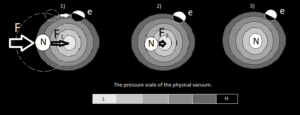Introduction
The physical nature of the issues of inertia and mutual attraction is practically not reflected in modern literature. According to the author, any physical body has a mass, the measure of which is the acceleration created by the gravitational waves of the body in the surrounding bodies. Only in interaction with the surrounding bodies is the body mass known. Only the test masses of accelerometers can be used to measure the body mass. We can distinguish two ways of interaction of a massive body with surrounding bodies: interaction with a physical vacuum (inertia) and interaction with other bodies by means of a physical vacuum (mutual attraction).
Goals, tasks.
The purpose of this article is to explain the physical nature of inertia and mutual attraction. The task is to prove that these phenomena are generated by the action of gravitational waves, which are emitted by all massive bodies.
Scientific novelty.
Inertia — the property of a body to remain in a state of rest or uniform rectilinear motion in the absence of external forces, as well as to prevent changes in its speed in the presence of external forces due to its inert mass.Quantitatively, the relationship between the force acting on the body and the change in its motion is given by the formulas of the first and second Newton’s laws.
V=const; when F=0 (1)
F-m*a; when 0<F<0 (2)
m-масса bodies;
a-ускорение bodies;
The reason for the inertia property is the interaction of massive bodies with a physical vacuum, whose photons are repelled from baryonic matter due to the fact that the linear speed of rotation of the surface of photons is higher than the linear speed of electrons of baryonic matter with which photons interact The nuclei of atoms of baryonic matter consist of nucleons, the rotation speed of which, on the contrary, is higher than the rotation speed of photons and therefore the nucleons attract (absorb) photons. As a result, a zone of reduced pressure of the physical vacuum is formed around the nucleons, where photons rush, but are repelled by electrons with the formation of gravitational waves (Fig. 1).

Figure 1. Inertia. Interaction of a massive body with a physical vacuum.
When an external force acts on the electron lattice, it shifts in the direction of the force, but the atomic nuclei do not shift (Fig.1, 1). There is a shift in the mass of the atoms, which continues (Fig.1, 2) until the atomic nuclei occupy their position in the zone of the minimum pressure of the physical vacuum inside the electron lattice (Fig.1, 3).
If there is a displacement of the center of inertia in a rotating body, the body moves in the direction of the displacement of the center of inertia at a speed of:
V=ΔR*n; (3)
where:
V is the velocity of the body;
ΔR-displacement of the center of inertia;
R — radius of the body;
n — the number of revolutions of the body;
All interactions both inside the atoms and outside them occur by gravitational waves. Gravitational inertial accelerations caused by external forces can be detected by any type of accelerometer. The external force is applied only to the body of the device, but not to the test mass, and this is the main difference between the detection of inertia and the detection of mutual attraction, where an external force is applied to both the test mass and the body together with the body on which it is installed. The inertial motion of the body is carried out due to the displacement of the center of mass of the body and it is quite possible to artificially create a displacement of the center of mass for the movement of bodies in a physical vacuum. One option is to excite a tidal wave in a rotating massive body, directed in the direction of the expected movement.

Figure 2. Mutual attraction of bodies. Interaction of massive bodies by means of a physical vacuum.
The mutual attraction of bodies (1) and (2) is shown in (Fig.2). Around baryonic bodies, the pressure of the physical vacuum decreases due to the repulsion of gravitational waves. Gravitational waves create zones of reduced pressure of the physical vacuum on the baselines connecting massive bodies, where the bodies are drawn by the gravitational waves of the physical vacuum. Formula (4) expresses the law of mutual attraction of I. Newton.
F= G*m1*m2/R^2 (4)
F — the force of attraction;
G is the gravitational constant;
m1*m2 — body masses;
R — distance between the bodies;
The formula expresses only the general dependence of acceleration on distance. When differentiating the formula, there are derivatives that express the increasing dependence of the acceleration as the distance decreases, which determine the tidal accelerations:
a2=G*m1/R^2 +2G1*m1*ΔR/R^3….. (1+n)Gn* m1*ΔR /R^(2+n) (5)
where: G1,…Gn are the gravitational constants for the acceleration derivatives;
For a certain distance, there is a certain band of derivatives that are crucial in the magnitude of the acceleration. Hence the notion that Newton’s law does not work in the microcosm. It works, but you need to apply it correctly, taking into account the derivatives. The author suggests that I. Newton, when he said that «he has no other inventions», did exactly this, but this should be carefully investigated by historians of the sciences of mathematics and physics. He could not leave his law unfinished.
The dependence of the forces of mutual attraction on tidal accelerations makes it possible to separate them from the inertial forces. The inertial forces do not depend on the directions, and the forces of attraction depend on the direction to the interacting body. This makes it possible to select bodies in different directions and to carry out the gravitational location of bodies. The location of gravitational bodies by rotating accelerometers is particularly effective, since their sensitivity increases due to an increase in the rotation frequency (w2) in accordance with the tidal acceleration formula for rotating bodies (w2):
w2 = 2G1*m1*[ R1*ω1* sin (ω1* t+ φ1) — R2*ω2*sin(ω2* t+ φ2)]/R^3 (6)
where: G1 is the gravitational constant for the first derivative of the acceleration;
ω1, ω2 — angular velocities of rotation;
φ1, φ2 — initial rotation angles;
R1, R2 — radii of rotation of bodies;
The strength of gravitational interactions is best described by the LIGO laboratory’s report on the discovery of gravitational waves, given at the link:https://journals.aps.org/prl/abstract/10.1103/PhysRevLett.116.061102
On September 14, 2015, at 09: 50: 45 UTC, two detectors of the laser interferometer gravitational-wave observatory simultaneously observed a transient gravitational-wave signal. The signal propagates upward at a frequency of 35 to 250 Hz with a peak gravitational wave strain of 1.0×10-21. It corresponds to the waveform predicted by General Relativity for the inspiration and fusion of a pair of black holes and the annular decay of the resulting single black hole. The signal was observed at a signal-to-noise ratio of a matched filter of 24 and a false alarm frequency of less than 1 event per 203,000 years, which is equivalent to a value greater than 5.1 σ. The source lies at a luminosity distance of 410 (+160/-180) MPC corresponds to a redshift of z=0.09 (+0.03/-0.04). In the original frame, the initial mass of the black hole is 36 (+5/-4)MS 29(+4-4)MS and the final mass of the black hole is 62 (+4-4)MS, with 3.0 (+0.5−0.5) MS*c^2 radiated by gravitational waves. All the uncertainties determine 90% of the reliable intervals. These observations demonstrate the existence of binary systems of stellar-mass black holes. This is the first direct detection of gravitational waves and the first observation of binary black hole mergers.
From the author: the observations were carried out to prove the existence of gravitational waves predicted by A. Einstein, as gravitational waves that occur during the merger of black holes. Other gravitational waves (including those from nearby sources) did not interest the LIGO laboratory and were filtered out by special filters. Three times the mass of the Sun went into the gravitational waves, which is about five percent of the original mass. These five percent of the initial mass went, first of all, to shift the centers of inertia of the photons of the physical vacuum.
Conclusion.
The inertial motion of the body is carried out due to the displacement of the center of mass of the body in the direction of the force acting, and it is quite possible to artificially create a displacement of the center of mass for the movement of bodies in a physical vacuum. The mutual attraction of massive bodies occurs due to the creation by gravitational waves of bodies of zones of low pressure of the physical vacuum on the baseline connecting the bodies, where the bodies are attracted.The forces of attraction depend on the direction of the interacting body. This allows the selection of bodies in the directions of rotating accelerometers and the gravitational location of the bodies.
